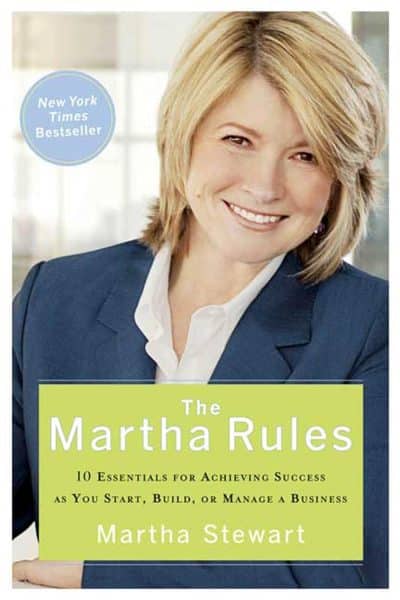Television personality and entrepreneur Martha Stewart spent five months in prison in 2004, after three years of investigation and a six-week trial. She was convicted on four counts, including lying to federal investigators, obstruction of justice, and conspiracy, after a series of events related to her ImClone Systems stock sale in 2001. Although accused of insider trading, Stewart wasn’t found guilty of this specific charge. She served her time, talked about it transparently, and rebuilt her brand, despite the initial difficulties her media empire Martha Stewart Living Omnimedia experienced.
At Business2Community, we’ve prepared a comprehensive article on why Martha Stewart went to jail, by looking at news articles, interviews, videos, and documents. We will also cover business lessons on how she rebuilt her brand and turned the unfortunate experience to her advantage.
Martha Stewart’s Jail Time – Key Facts
- Martha Stewart was accused of insider trading at the end of 2001, when she sold nearly 4,000 shares in ImClone stock just one day before its value dropped sharply.
- In 2004, Stewart was found guilty of two counts of false statements, one count of conspiracy, and one count of obstruction of justice.
- After a five-month prison sentence, she was released in March 2005.
The Story of Why Martha Stewart Went to Jail
Martha Stewart made her fortune as the Queen of Domestic Arts in the 80s and 90s. She published a range of magazines cookbooks and hosted TV shows educating the American public in cooking, hosting, and entertaining.
Martha Stewart was sentenced to five months in prison in 2004 for conspiracy, obstruction of justice, and lying to investigators. These allegations were related to the 2001 insider trading scandal, when Stewart sold nearly 4,000 shares of ImClone stock one day before its value dropped.
2001: Insider Trading Allegations
Martha Stewart was a shareholder of ImClone Systems, a biopharmaceutical company.
In December 2001, ImClone expected to receive FDA approval for its new cancer drug, Erbitux. However, the FDA refused the application due to inadequate data and clinical trials. A rejection from the FDA would mean a sharp drop in the company’s stock.
ImClone CEO Sam Waksal found out about the FDA’s decision in advance and advised his daughter to sell her shares. He also attempted to sell $5 million worth of his own shares.
Samuel Waksal was also close friends with Martha Stewart. The fact that Stewart also sold her ImClone stocks drew attention. According to CNN Money, she was tipped by her broker Peter Bacanovic to sell her stocks, after Bacanovic found out Waksal was selling his stocks.
One day before the ImClone stock plummeted, Stewart sold nearly 4,000 stocks worth $229,000.
2002: More Investigations on Martha Stewart’s Involvement
In 2002, investigators asked for Martha Stewart’s phone and email records related to the ImClone stock.
Stewart denied wrongdoing, saying she had a prior agreement with Bacanovic to sell the shares if the stock price fell below $60. Bacanovic and his assistant Doug Faneuil gave contradictory statements, with Faneuil claiming he advised Stewart to sell her shares before the stock dropped, while Bacanovic denied passing on any improper information.
A day after Doug Faneuil pleaded guilty, Martha Stewart resigned from the Board of Directors of the New York Stock Exchange. “The decision to join or leave the board of the NYSE is a personal one for Ms. Stewart,” said a spokeswoman at Stewart’s company.
2003: Martha Stewart Steps Back as CEO
In 2003, Martha Stewart stepped back as CEO and chairman of her lifestyle brand, Martha Stewart Living Omnimedia.

On June 4 of the same year, the Securities and Exchange Commission filed a civil lawsuit against Stewart and her broker Peter Bacanovic for illegal insider trading. Also in June 2003, Martha Stewart was accused of securities fraud and of making false statements to protect her own company’s stocks. She was charged with conspiracy, obstruction of justice, and lying. Said federal prosecutor James Comey:
This criminal case is about lying – lying to the FBI, lying to the SEC, lying to investors.
“Whatever happened with Martha did not happen because she spoke to the CEO of ImClone. Period. She never did. Therefore, I didn’t give Martha Stewart insider information. Period,” Sam Waksal told CBS in 2003.
2004: Martha Stewart Goes to Alderson Federal Prison Camp
Martha Stewart was found guilty in 2004 of two counts of false statements, one count of conspiracy, and one count of obstruction of justice. She was found not guilty of securities fraud.
“Dear Friends: I am obviously distressed by the jury’s verdict but I take comfort in knowing that I have done nothing wrong and that I have the enduring support of my family and friends,” wrote Stewart on her website.
Stewart served five months in Alderson Federal Prison Camp, West Virginia, followed by five months house arrest and two years of probation.
2006: Insider Trading Charge Settlement
The SEC and Martha Stewart settled the insider trading charges in 2006.
Stewart agreed to a financial penalty, including disgorgement of avoided losses and a civil penalty, totaling about $195,000. She also agreed to a five-year ban from serving as a director of a public company.
The Consequences to Martha Stewart of Her Conviction
Martha Stewart’s conviction, five-month prison sentence, and five-month house arrest had the following consequences for her business and personal brand:
Martha Stewart Living Omnimedia and Fans
In 2003, when Martha Stewart was still scheduled to stand trial, the New York Times reported that Martha Stewart Living’s advertising pages decreased by 33% for the first 10 months of the year. As a result, the company lowered its rates for one-page, four-color advertisements from $129,766 to $107,640.

Martha Stewart Living experienced leadership changes, when Sharon Patrick was replaced with Susan Lyne as CEO in 2004.
In 2018, Lyne spoke to Business Insider about leading the company during this delicate period. She mentioned that rebuilding the company’s brand became easier once Stewart decided to go to jail.
“It [the brand] was doing incredibly well until she was indicted and ultimately convicted. I was on the board at the time, and I saw a couple of things. One was that her customers did not leave. They, in fact, doubled down on her. We were seeing people who were taking two-year subscriptions instead of one-year subscriptions; they were buying more products at Kmart,” she said, highlighting the fans’ key role in rebuilding the company.
Drop in Martha Stewart’s Net Worth
Martha Stewart was the first woman to achieve billionaire status when Martha Stewart Living Omnimedia, her own company, went public in 1999. However, the trials and conviction meant she lost her billionaire status, as her company’s stock fell in 2002.
According to CNN Money, Martha Stewart’s holdings in her company dropped nearly $200 million in value, over a quarter of her net worth.
As of 2024 Martha Stewart’s net worth is approximately $400 million.
Books and TV Shows
When Martha Stewart was in prison, her fellow inmates were curious about her business and how she became so successful.
She shared her knowledge in various ways, such as giving a seminar on business practices. This seminar inspired her 2005 book, The Martha Rules: 10 Essentials for Achieving Success as You Start, Build, or Manage a Business.

Stewart’s prison time inspired other writers and directors, who produced titles including the 2005 film Martha Behind Bars, the 2016 book In Prison with Martha Stewart, and the 2024 miniseries The Many Lives of Martha Stewart.
Public Appearances
After her release, Martha Stewart appeared on many TV shows, such as Letterman and Ellen DeGeneres‘ The Ellen Show, where she talked about her experience transparently. On Letterman, she highlighted her decision to serve time instead of appealing to the decision and discussed the mental and physical strength she gained from the ordeal.
During a brunch at Cannes Lions in 2018, she discussed what she did in prison including her ceramics classes where she built an entire nativity scene. She later put the replicas of the nativity scene on sale.
What Can We Learn From Martha Stewart’s Jailing?
“I knew I was strong going in and I was certainly stronger coming out,” said Martha Stewart to Harpers Bazaar in 2021. Thanks to her crisis management skills, Martha Stewart rebuilt her brand and gained a new fanbase.
Transparency and a strong brand can help companies recover from difficult situations. Here is how Martha Stewart used both to recover her business:
Transparency and Being Proactive
From the very beginning, Martha Stewart managed the crisis very well. In an interview in which she reacted to her prison sentence, Stewart spoke calmly and thanked all her supporters. She gained sympathy when she apologized to her employees who lost their jobs.
After serving her sentence, Stewart openly talked about her time in prison and the circumstances. She detailed her prison activities and experience, which appeared honest and heartfelt.
Strategic Brand Building
Martha Stewart’s brand continued to emphasize its core values of quality and reliability. Even during her absence, her company maintained its commitment to these principles.
When she got out of prison, Stewart continued rebuilding her brand by taking on projects beyond prison-related talk shows, such as returning to her daytime talk show the Martha Stewart Show.
In an interview with Bloomberg, she mentioned how important television shows had been for her brand and credibility. By engaging with her audience through TV shows and other media appearances, she was able to rebuild a connection and therefore, her brand. This, combined with transparency, increased public sympathy and trust and helped her move forward from the scandal.
